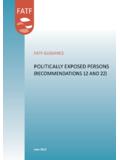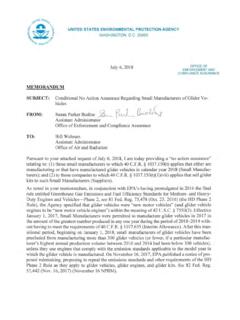Transcription of THE EQUAL RIGHTS AMENDMENT: FREQUENTLY ASKED …
1 THE EQUAL RIGHTS AMENDMENT: FREQUENTLY ASKED QUESTIONS. Roberta W. Francis ERA Education Consultant, Alice Paul Institute Founding Chair, ERA Task Force, National Council of Women's Organizations May 2017. The proposed EQUAL RIGHTS Amendment (ERA) to the United States Constitution is a political and cultural inkblot, onto which many people project their greatest hopes or deepest fears about the changing status of women. Since it was first introduced in Congress in 1923, the ERA has been an issue with both rabid support and fervid opposition. Interpretations of its intent and potential impact have been varied and even contradictory. These answers to FREQUENTLY ASKED questions about the ERA encourage evaluation of the amendment based on facts rather than misrepresentations. Further information, including how to order the 17-minute educational documentary The EQUAL RIGHTS Amendment: Unfinished Business for the Constitution, is available at 1.
2 What is the complete text of the EQUAL RIGHTS Amendment? Section 1: Equality of RIGHTS under the law shall not be denied or abridged by the United States or by any state on account of sex. Section 2: The Congress shall have the power to enforce , by appropriate legislation, the provisions of this article. Section 3: This amendment shall take effect two years after the date of ratification. This wording has been the text of the EQUAL RIGHTS Amendment since it was composed by suffragist leader and women's RIGHTS activist Alice Paul in 1943. The original ERA, written in 1923 by Paul, feminist lawyer/activist Crystal Eastman, and several others was known as the Lucretia Mott Amendment : Men and women shall have EQUAL RIGHTS throughout the United States and every place subject to its jurisdiction. Congress shall have power to enforce this article by appropriate legislation.
3 Beginning in the 113th Congress (2014-2015), the text of the ERA ratification bill introduced in the House of Representatives has differed slightly from both the traditional wording and its Senate companion bill. It reads: Section 1: Women shall have EQUAL RIGHTS in the United States and every place subject to its jurisdiction. Equality of RIGHTS under the law shall not be denied or abridged by the United States or by any State on account of sex. 1. Section 2: Congress and the several States shall have the power to enforce , by appropriate legislation, the provisions of this article. Section 3: This amendment shall take effect two years after the date of ratification. The addition of the first sentence specifically names women in the Constitution for the first time and clarifies the intent of the amendment to make discrimination on the basis of a person's sex unconstitutional.
4 The addition of "and the several States" in Section 2 restores wording that was drafted by Alice Paul but removed before the amendment's 1972 passage. It affirms that enforcement of the constitutional prohibition of sex discrimination is a function of both federal and state levels of government. 2. Why is an EQUAL RIGHTS Amendment to the Constitution necessary? The EQUAL RIGHTS Amendment would provide a fundamental legal remedy against sex discrimination for both women and men. It would guarantee that the RIGHTS affirmed by the Constitution are held equally by all citizens without regard to their sex. The ERA would clarify the legal status of sex discrimination for the courts, where decisions still deal inconsistently with such claims. For the first time, sex would be considered a suspect classification, as race currently is.
5 Governmental actions that treat males or females differently as a class would be subject to strict judicial scrutiny and would thus have to meet the highest level of justification a necessary relation to a compelling state interest to be upheld as constitutional. To actual or potential offenders who would try to write, enforce , or adjudicate laws inequitably, the ERA would send a strong preemptive message: the Constitution has zero tolerance for sex discrimination under the law. 3. What is the political history of the ERA? The EQUAL RIGHTS Amendment was written in 1923 by Alice Paul, a leader of the woman suffrage movement and a women's RIGHTS activist with three law degrees. It was introduced in Congress in the same year and subsequently reintroduced in every Congressional session for half a century.
6 In 1943 Alice Paul rewrote the text (now called the Alice Paul Amendment ), to its current wording, modeled on the language of the 19th Amendment, which states: The right of citizens of the United States to vote shall not be denied or abridged by the United States or by any State on account of sex. The 19th Amendment is the only explicitly affirmed guarantee of EQUAL RIGHTS for women in the Constitution. On March 22, 1972, the ERA finally passed the Senate and the House of Representatives by the required two-thirds majority and was sent to the states for ratification. An original seven-year deadline was later extended by Congress to June 30, 1982. When this deadline expired, only 35 of the necessary 38 states (the constitutionally required three-fourths) had ratified the ERA. It is therefore not yet a part of the Constitution.
7 2. The EQUAL RIGHTS Amendment has been reintroduced in every session of Congress since 1982. In the 115th Congress (2017-2018), ERA ratification bills were introduced as 6 (lead sponsor, Senator Robert Menendez, D-NJ) and 33 (lead sponsor, Representative Carolyn Maloney, D-NY). A bill to remove the ERA's ratification deadline ex post facto and make it part of the Constitution when three more states ratify was introduced as Res. 5 by Senator Benjamin Cardin (D-MD) and as 53 by Representative Jackie Speier (D-CA). 4. Which 15 states did not ratify the ERA by June 30, 1982? The 15 states whose legislatures did not ratify the EQUAL RIGHTS Amendment by the 1982 deadline are Alabama, Arizona, Arkansas, Florida, Georgia, Illinois, Louisiana, Mississippi, Missouri, Nevada, North Carolina, Oklahoma, South Carolina, Utah, and Virginia.
8 5. Why are these states being ASKED to ratify the ERA even though the 1982 deadline has passed? Since 1995, ERA supporters have advocated for passage of ERA ratification bills in a number of the 15 so-called unratified states. Such bills have been introduced in one or more legislative sessions in 12 of these states (Arizona, Arkansas, Florida, Illinois, Louisiana, Mississippi, Missouri, Nevada, North Carolina, Oklahoma, Utah, and Virginia). ERA bills have advanced in committees and even in floor votes in some of those states. The Illinois House, but not the Senate, passed an ERA ratification bill in 2003, and in 2014 the Illinois Senate passed a similar bill. In five of the six years between 2011 and 2016, the Virginia Senate passed a bill ratifying the EQUAL RIGHTS Amendment, but the House of Delegates did not allow a companion bill to be released from committee.
9 In a significant breakthrough, on March 22, 2017, 45 years to the day after Congress passed the amendment and sent it to the states for ratification, Nevada became the 36th state to ratify the ERA. In 2017 ERA bills have also been introduced in the legislatures of Arizona, Florida, Illinois, North Carolina, Utah, and Virginia. This political activity is the result of a three-state strategy for ERA ratification that was developed after the 1992 ratification of the 27th ( Madison ) Amendment to the Constitution more than 203 years after its 1789 passage by Congress. Acceptance of that ratification period as sufficiently contemporaneous has led some ERA supporters to argue that Congress has the power to maintain the legal viability of the ERA's existing 35 state ratifications. The time limit on ERA. ratification is open to change, as Congress demonstrated in extending the original deadline, and precedent with the 14th and 15th Amendments shows that rescissions (legislative votes retracting ratifications) are not accepted as valid.
10 Therefore, Congress may be able to accept state ratifications that occur after 1982 and keep the existing 35 ratifications alive. The legal analysis for this strategy is explained in The EQUAL RIGHTS Amendment: Why the ERA. Remains Legally Viable and Properly Before the States by Allison Held et al. in the Spring 1997. issue of William & Mary Journal of Women and the Law. 3. The Library of Congress's Congressional Research Service discussed this article in its 1996, 2013, and 2014 reports on the status of ERA ratification, and CRS analysts concluded that acceptance of the Madison Amendment does have implications for the three-state strategy. The issue, they said, is more of a political question than a constitutional one. Beginning in 1994, Representative Robert Andrews (D-NJ) introduced a bill in each Congressional session stating that when an additional three states ratify the ERA, the House of Representatives shall take any necessary action to verify that ratification has been achieved.







